Effect of Blending and Curing Conditions on the Storage Stability of Rubberized Asphalt Binders
Abstract
1. Introduction
2. Experimental Design
2.1. Materials
2.2. Production and Sampling of CRM Asphalt Binders
2.3. Binder Evaluation
2.3.1. Rotational Viscosity
2.3.2. Rheological Property and MSCR
2.3.3. Separation Index (SI)
3. Results and Discussions
3.1. Rotational Viscosity
3.2. Rheological Property
3.3. MSCR Test
3.4. Storage Stability Results
4. Conclusions
- Adding CRM resulted in an increasing trend for rotational viscosity at temperatures of 135 °C and 180 °C, as per expectations. Method C appeared to have the most prominent effect when decreasing the difference between the values of the top and bottom parts, while methods A and B resulted in high differences;
- An increasing trend for G*/sin δ was witnessed as the CRM was added. The result for 5% CRM using method C showed that there were no differences among the values of the top, middle, and bottom parts, suggesting method C can be effective for storage stability. By contrast, methods A and B remained high regarding the differences between the top and bottom parts, as per the rotational viscosity results;
- In the MSCR test, percentage recovery was measured, resulting in an increasing trend with increasing CRM content. However, even though method C allowed for an effective decrease in the difference between the values of the top and bottom parts, all mixing methods showed relatively big differences between these parts when compared to the data from the rotational viscosity and rheological properties;
- For the storage stability of CRM asphalt binder, it was observed that method C improved storage stability; in particular, when using G*/sin δ of 5% CRM, the results indicated a 0% separation index. On the other hand, the results for percentage recovery were relatively higher than the separation index using rotational viscosity and G*/sin δ;
- In this study, it was confirmed that designing a mixing method for CRM asphalt binders is important for storage stability. The main reason is that the mixing methods can affect the digestion of the CRM particles, which allows them to be dissolved into the asphalt binder. Moreover, since the SI results vary depending on the experimental method standards, without taking this into consideration, the results do not present a correct conclusion about storage stability;
- Much uncertainty still exists about the relationship among modifiers, mixing methods, and the factors for calculating the separation index. Comprehensive research is required to suggest practical methods for increasing storage stability.
Author Contributions
Funding
Institutional Review Board Statement
Informed Consent Statement
Data Availability Statement
Conflicts of Interest
References
- Liu, X.-Y.; Wang, P.; Lu, Y.; Zhang, T.-T.; Wang, L.-Z.; Wang, T.-F. Identifying the Thermal Storage Stability of Polymer-Modified Asphalt with Carbon Nanotubes Based on Its Macroperformance and Micromorphology. Adv. Mater. Sci. Eng. 2021, 2021, 1–17. [Google Scholar] [CrossRef]
- Willis, J.R. Use of ground tire rubber in a dense-graded asphalt mixture on us 231 in alabama: A case study. In Airfield and Highway Pavement 2013: Sustainable and Efficient Pavements; 2013; pp. 1192–1201. Available online: https://ascelibrary.org/doi/10.1061/9780784413005.100 (accessed on 20 December 2022).
- Baumgardner, G.; Hand, A.J.; Aschenbrener, T.B. Resource Responsible Use of Recycled Tire Rubber in Asphalt Pavements. 2020. Available online: https://www.fhwa.dot.gov/pavement/asphalt/hif20043.pdf (accessed on 20 December 2022).
- Han, L.; Zheng, M.; Wang, C. Current status and development of terminal blend tyre rubber modified asphalt. Constr. Build. Mater. 2016, 128, 399–409. [Google Scholar] [CrossRef]
- Khalili, M.; Jadidi, K.; Karakouzian, M.; Amirkhanian, S. Rheological properties of modified crumb rubber asphalt binder and selecting the best modified binder using AHP method. Case Stud. Constr. Mater. 2019, 11, e00276. [Google Scholar] [CrossRef]
- Salem, M.E.; Awed, A.M.; El-Badawy, S.M.; Xiao, F. Comprehensive physico-chemical and rheo-mechanical characterization of multiple asphalt binder microphases to meet Egyptian conditions. Case Stud. Constr. Mater. 2022, 17, e01539. [Google Scholar] [CrossRef]
- Rath, P. State of Knowledge Report on Rubber Modified Asphalt. 2021. Available online: https://www.ustires.org/sites/default/files/2021-06/Rubber-Modified-Asphalt_5-27-2021-FINAL.pdf (accessed on 20 December 2022).
- Navarro, F.J.; Partal, P.; Martınez-Boza, F.; Gallegos, C. Thermo-rheological behaviour and storage stability of ground tire rubber-modified bitumens. Fuel 2004, 83, 2041–2049. [Google Scholar] [CrossRef]
- Pérez-Lepe, A.; Martínez-Boza, F.J.; Gallegos, C. High temperature stability of different polymer-modified bitumens: A rheological evaluation. J. Appl. Polym. Sci. 2007, 103, 1166–1174. [Google Scholar] [CrossRef]
- Sienkiewicz, M.; Borzędowska-Labuda, K.; Wojtkiewicz, A.; Janik, H. Development of methods improving storage stability of bitumen modified with ground tire rubber: A review. Fuel Process. Technol. 2017, 159, 272–279. [Google Scholar] [CrossRef]
- Ren, Z.; Zhu, Y.; Wu, Q.; Zhu, M.; Guo, F.; Yu, H.; Yu, J. Enhanced Storage Stability of Different Polymer Modified Asphalt Binders through Nano-Montmorillonite Modification. Nanomaterials 2020, 10, 641. [Google Scholar] [CrossRef] [PubMed]
- Yu, J.; Ren, Z.; Yu, H.; Wang, D.; Svetlana, S.; Korolev, E.; Gao, Z.; Guo, F. Modification of Asphalt Rubber with Nanoclay towards Enhanced Storage Stability. Materials 2018, 11, 2093. [Google Scholar] [CrossRef] [PubMed]
- Salazar-Cruz, B.; Zapien-Castillo, S.; Hernández-Zamora, G.; Rivera-Armenta, J. Investigation of the performance of asphalt binder modified by sargassum. Constr. Build. Mater. 2021, 271, 121876. [Google Scholar] [CrossRef]
- Wen, Y.; Liu, Q.; Chen, L.; Pei, J.; Zhang, J.; Li, R. Review and comparison of methods to assess the storage stability of terminal blend rubberized asphalt binders. Constr. Build. Mater. 2020, 258, 119586. [Google Scholar] [CrossRef]
- Zheng, W.; Wang, H.; Chen, Y.; Ji, J.; You, Z.; Zhang, Y. A review on compatibility between crumb rubber and asphalt binder. Constr. Build. Mater. 2021, 297, 123820. [Google Scholar] [CrossRef]
- Abdelrahman, M.; Carpenter, S. Controlling Low Temperature Properties of Asphalt-Rubber Binders. In Proceedings of the 1998 Annual Conference of the Canadian Society for Civil Engineering, Halifax, NS, Canada, 10–13 June 1998. [Google Scholar]
- Glover, C.J.; Davison, R.R.; Bullin, J.A.; Estakhri, C.K.; Williamson, S.A.; Billiter, T.C.; Chipps, J.F.; Chun, J.S.; Juristyarini, P.; Leicht, S.E. A comprehensive laboratory and field study of high-cure crumb-rubber modified asphalt materials (No. FHWA/TX-01/1460-1). 2000. Available online: http://tti.tamu.edu/documents/1460-1.pdf (accessed on 20 December 2022).
- Oliver, J.W. Modification of paving asphalts by digestion with scrap rubber. In Proceedings of the 60th Annual Meeting of the Transportation Research Board, Washington, DC, USA, 12–16 January 1981. [Google Scholar]
- Presti, D.L.; Airey, G.; Partal, P. Manufacturing terminal and field bitumen-tyer rubber blends: The importance of processing conditions. Procedia-Soc. Behav. Sci. 2012, 53, 485–494. [Google Scholar] [CrossRef]
- Yun, J.; Hemmati, N.; Lee, M.-S.; Lee, S.-J. Laboratory Evaluation of Storage Stability for CRM Asphalt Binders. Sustainability 2022, 14, 7542. [Google Scholar] [CrossRef]
- Kim, H.; Lee, S.-J. Laboratory Investigation of Different Standards of Phase Separation in Crumb Rubber Modified Asphalt Binders. J. Mater. Civ. Eng. 2013, 25, 1975–1978. [Google Scholar] [CrossRef]
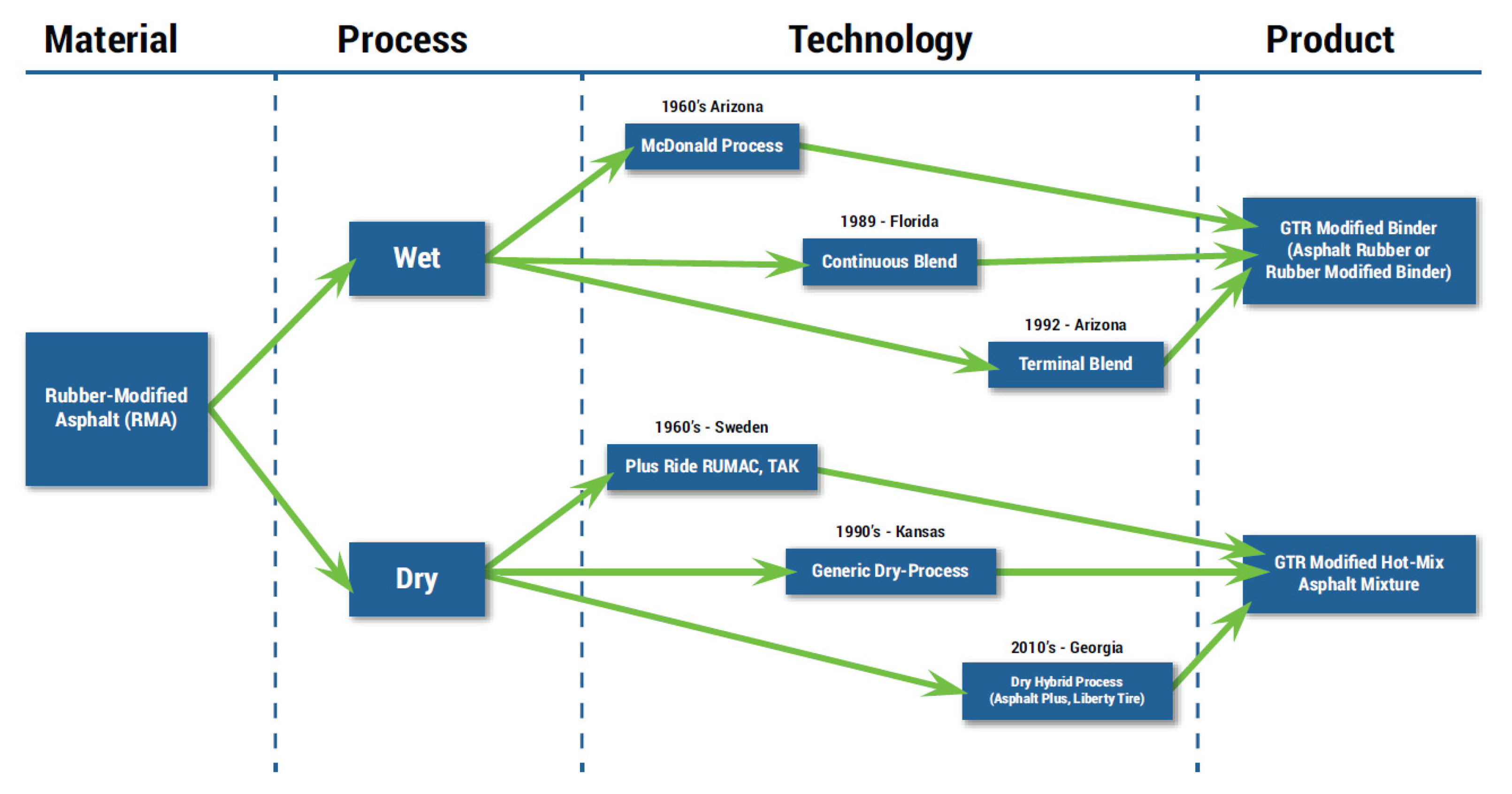
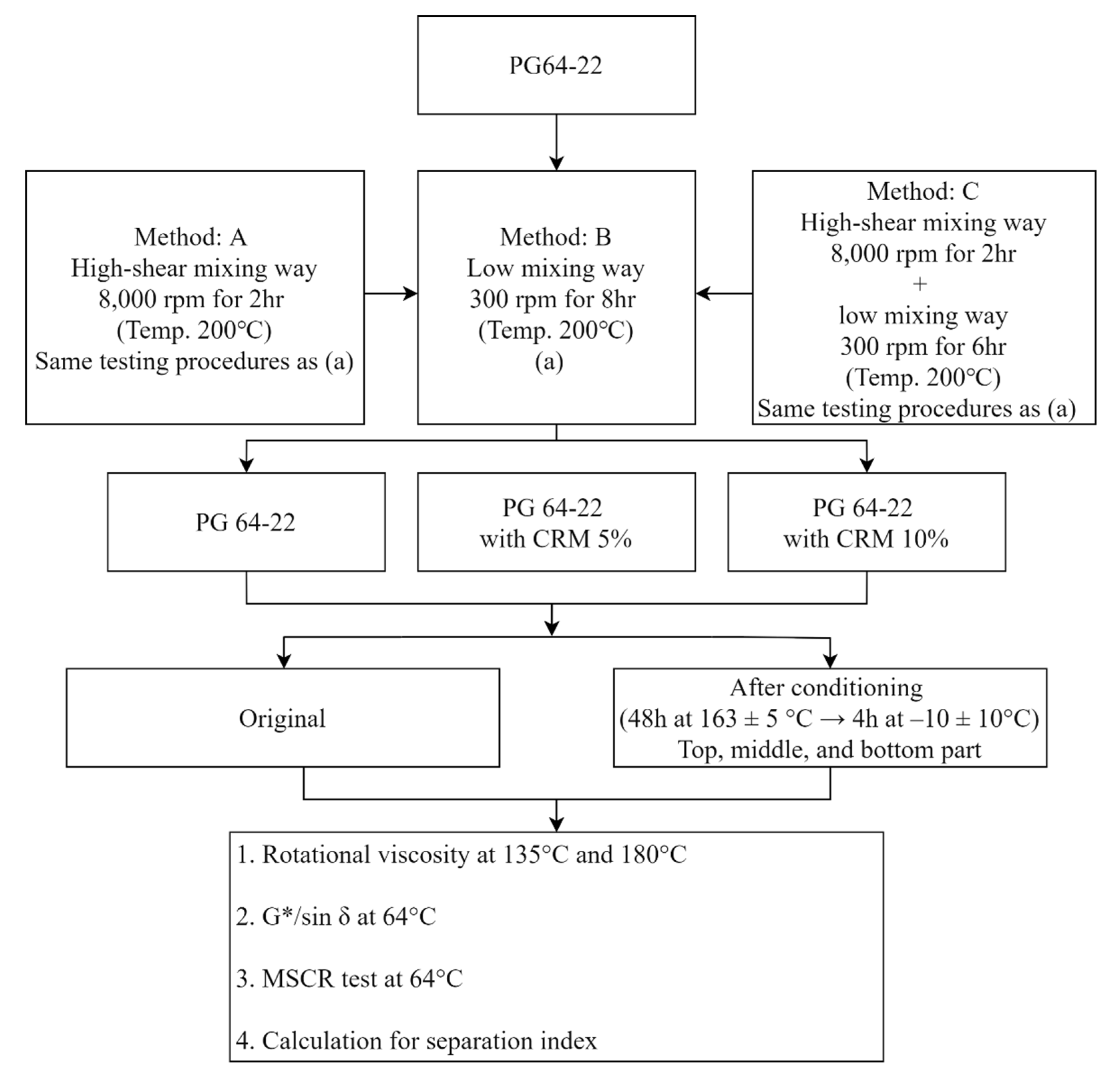
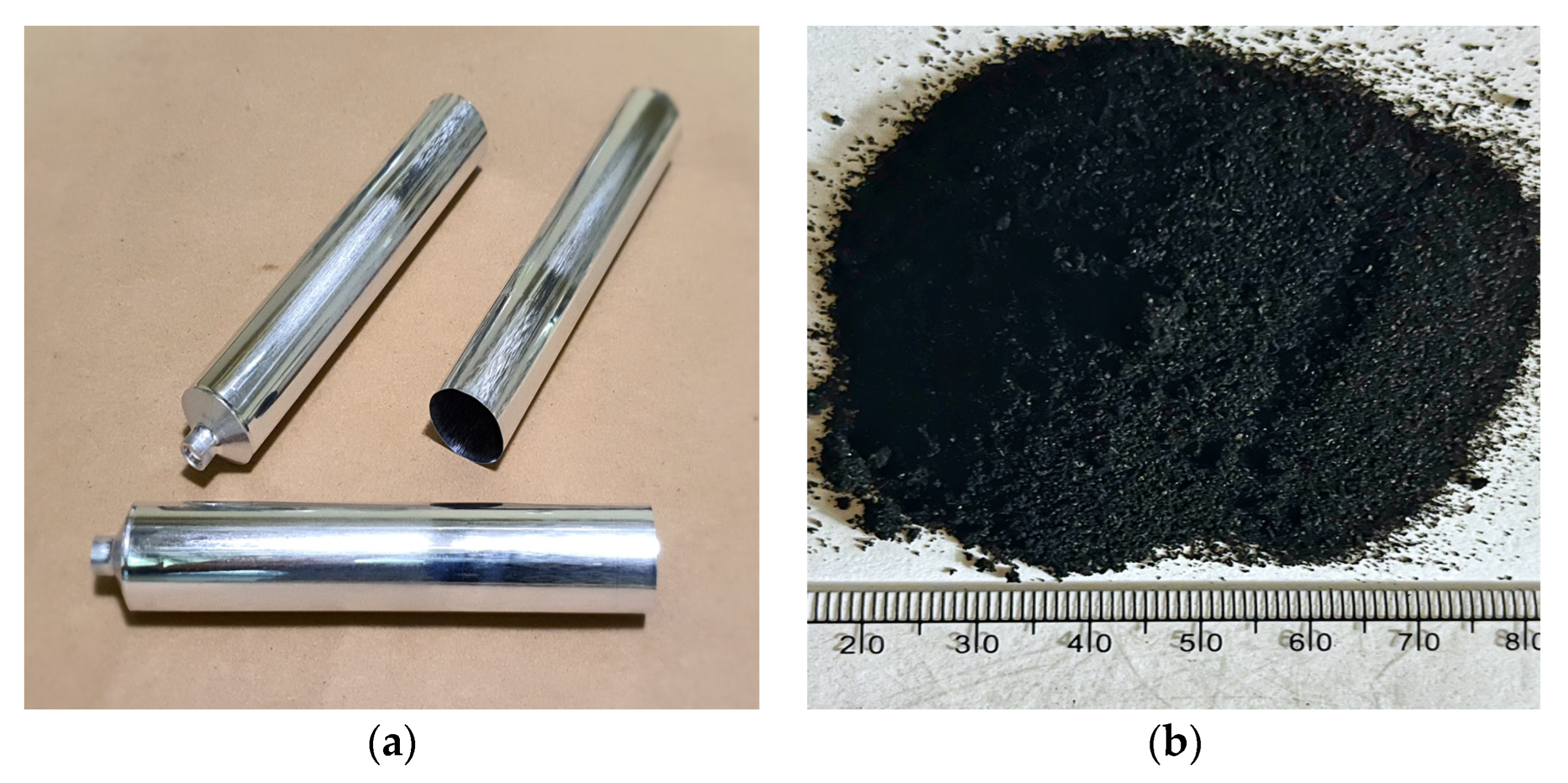
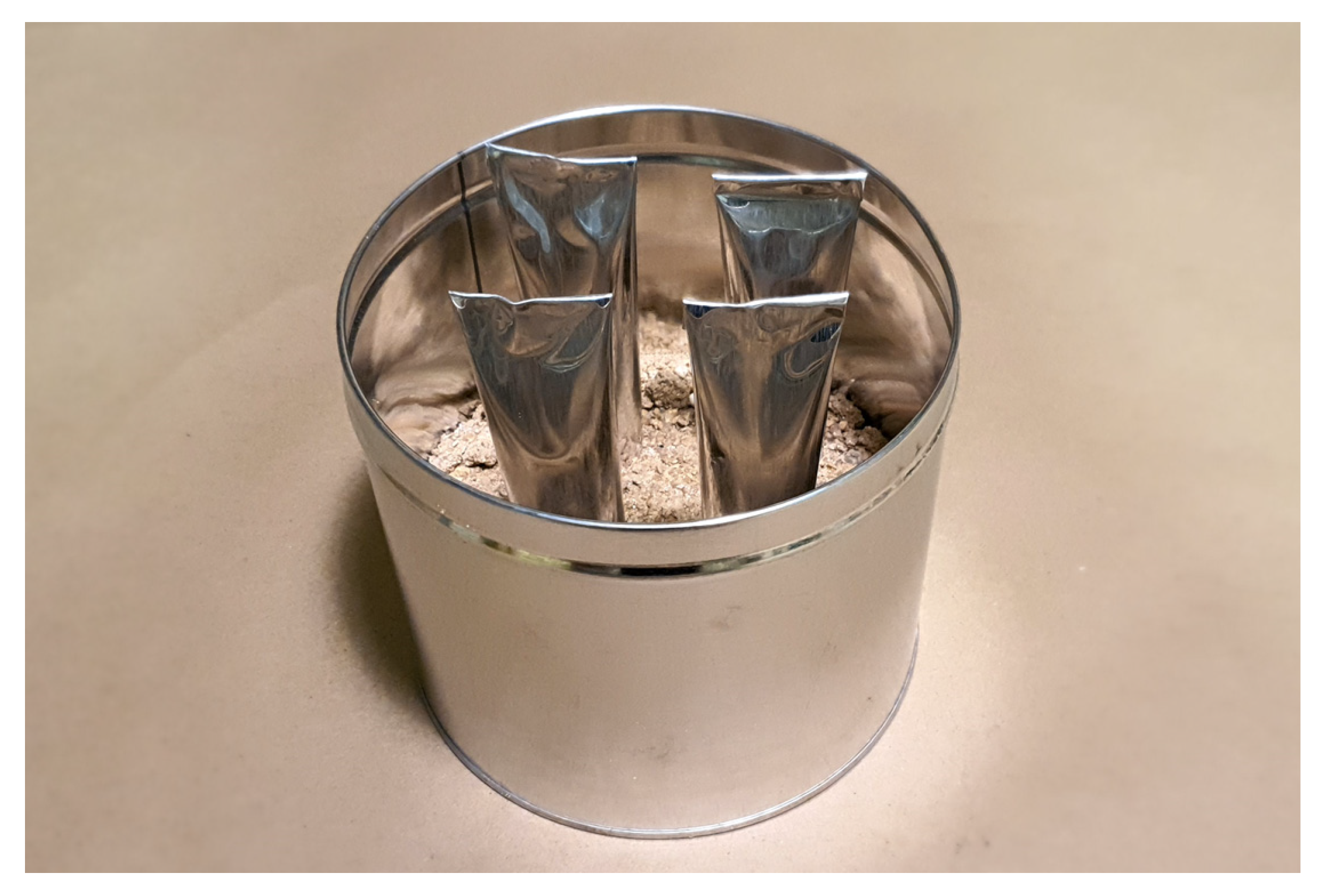
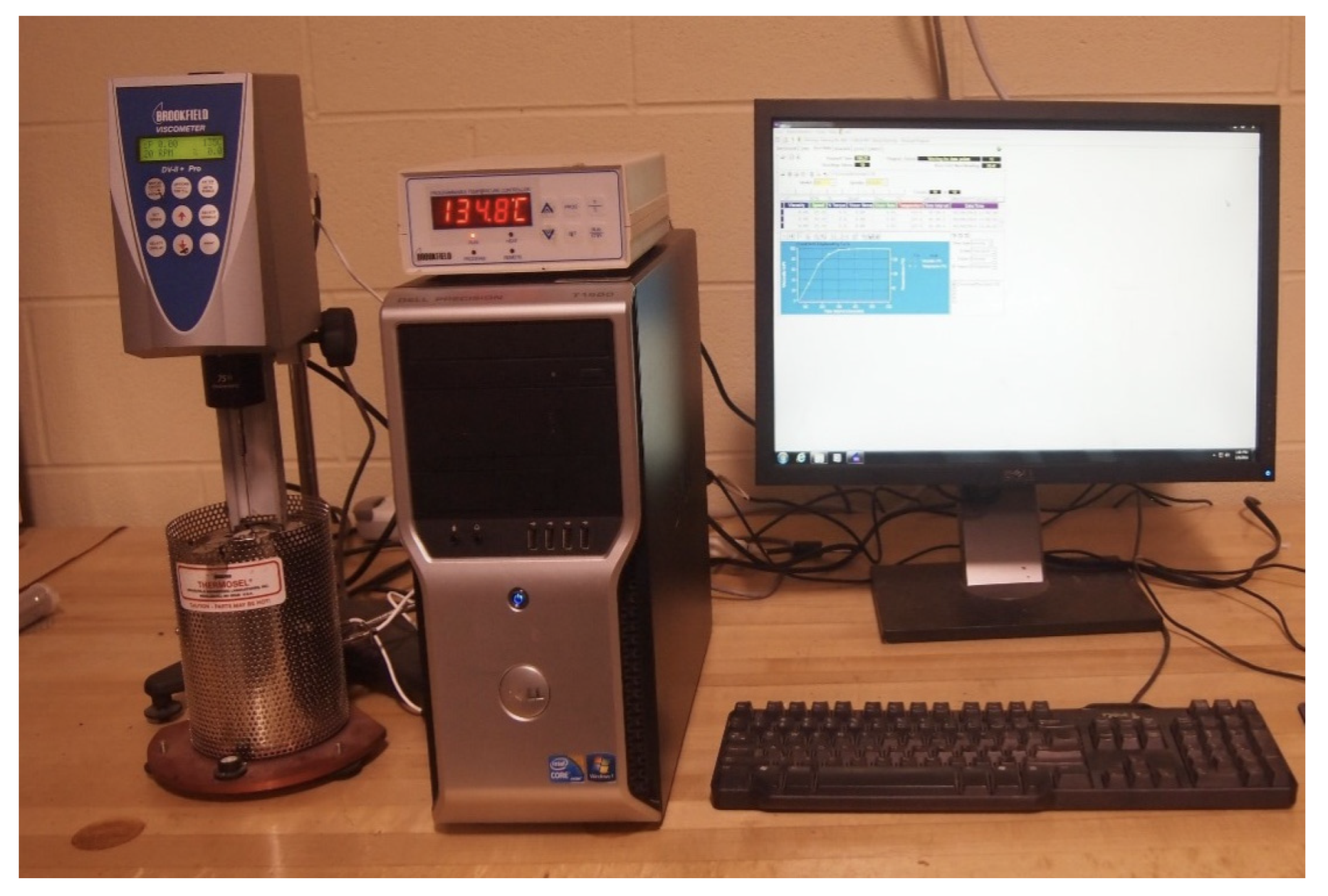
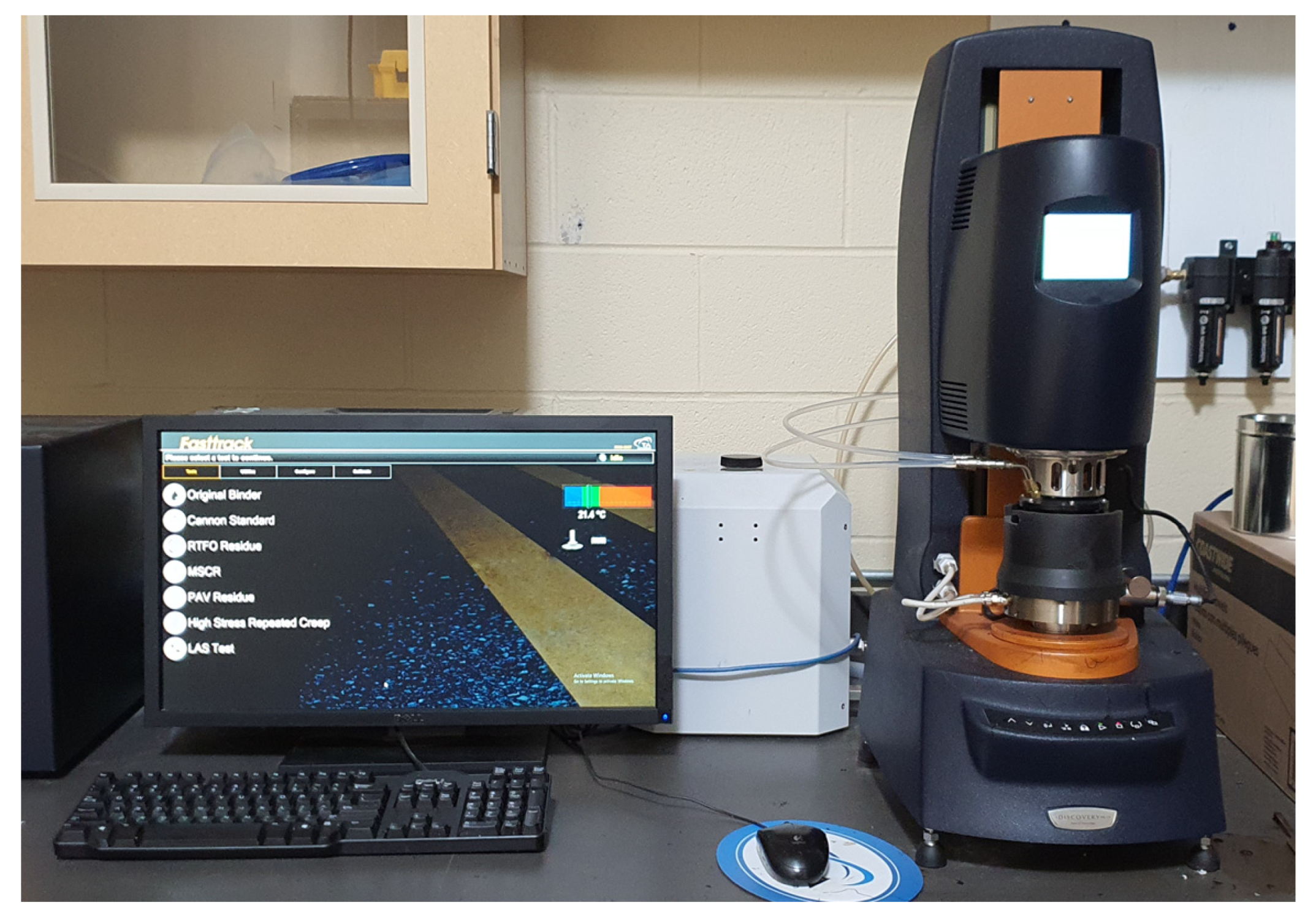
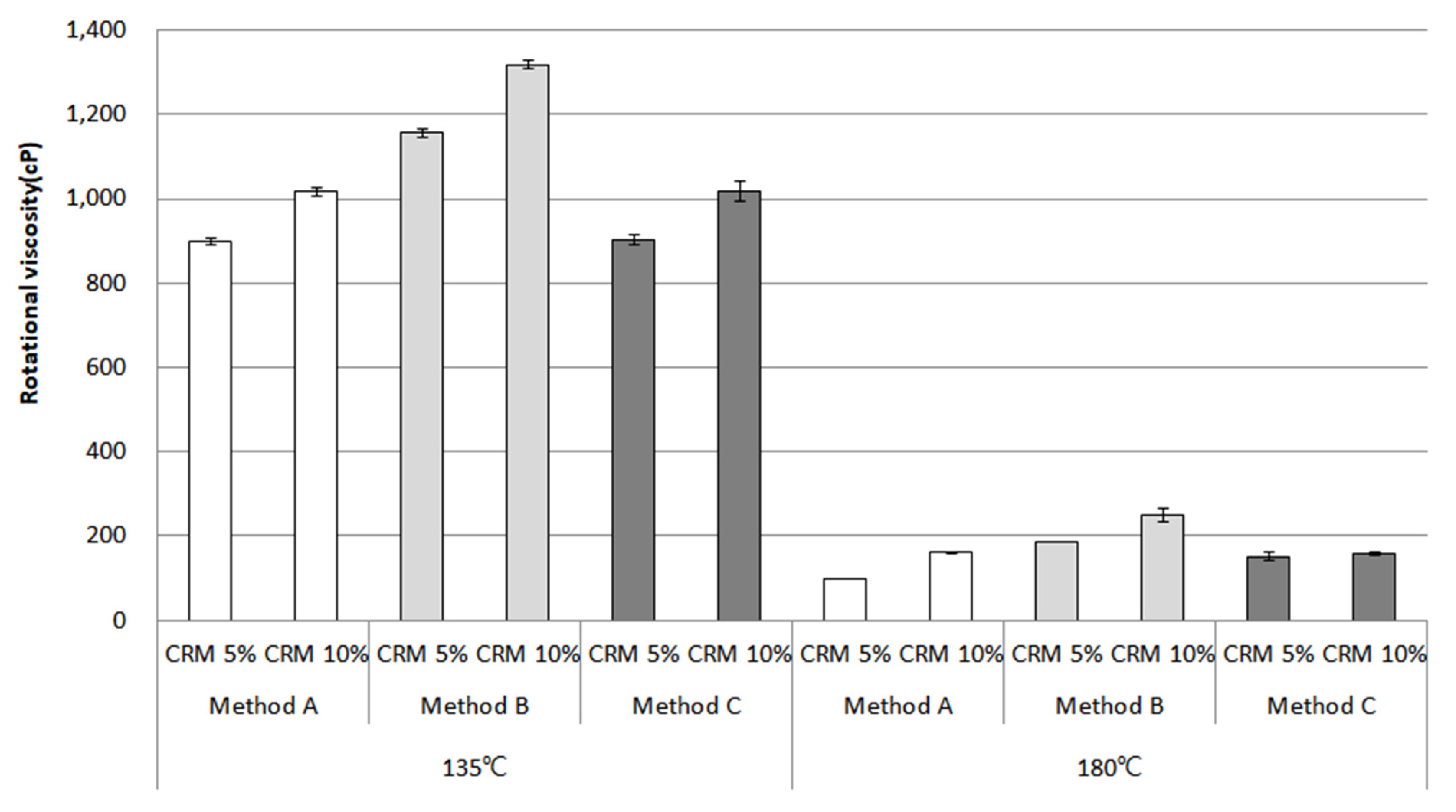
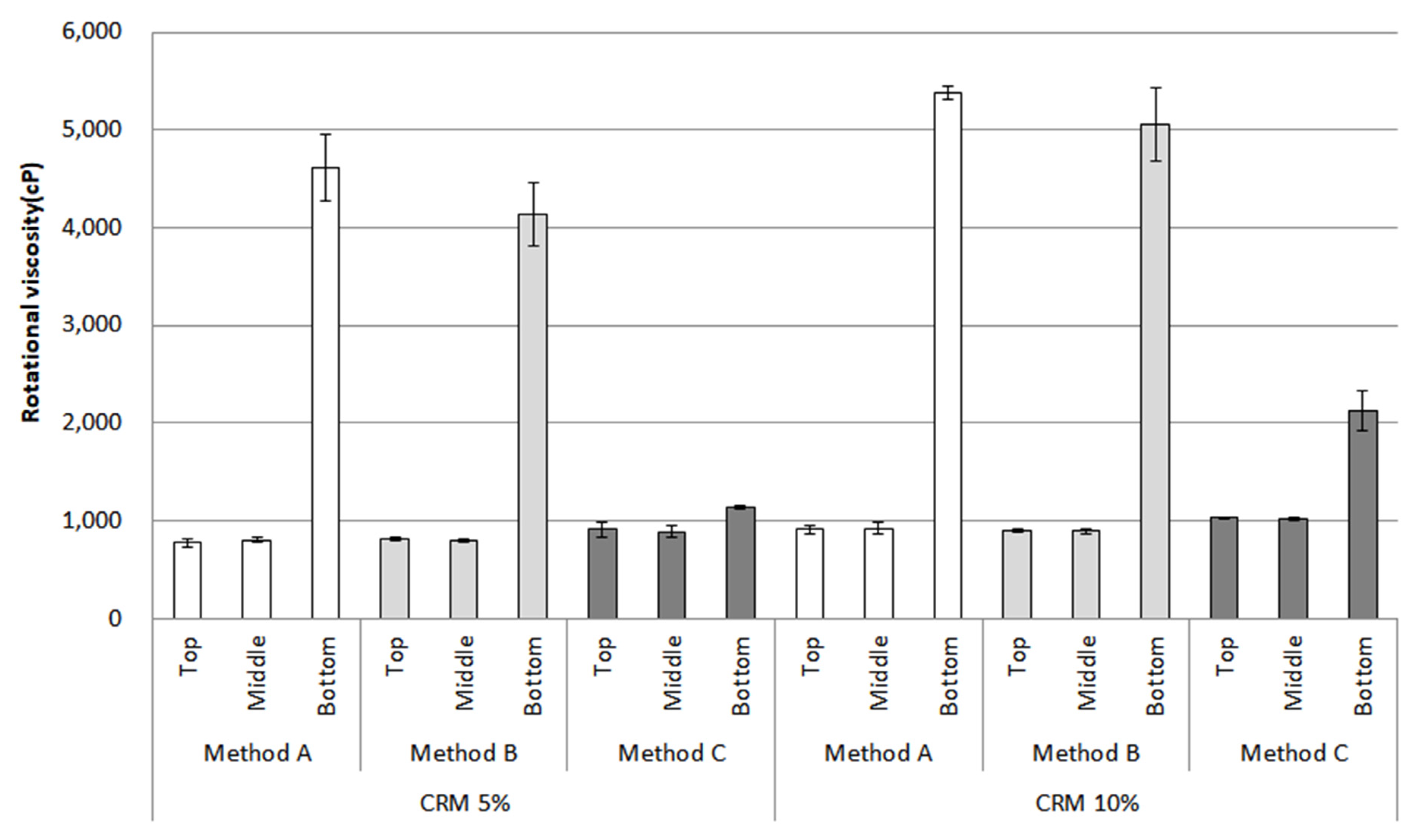

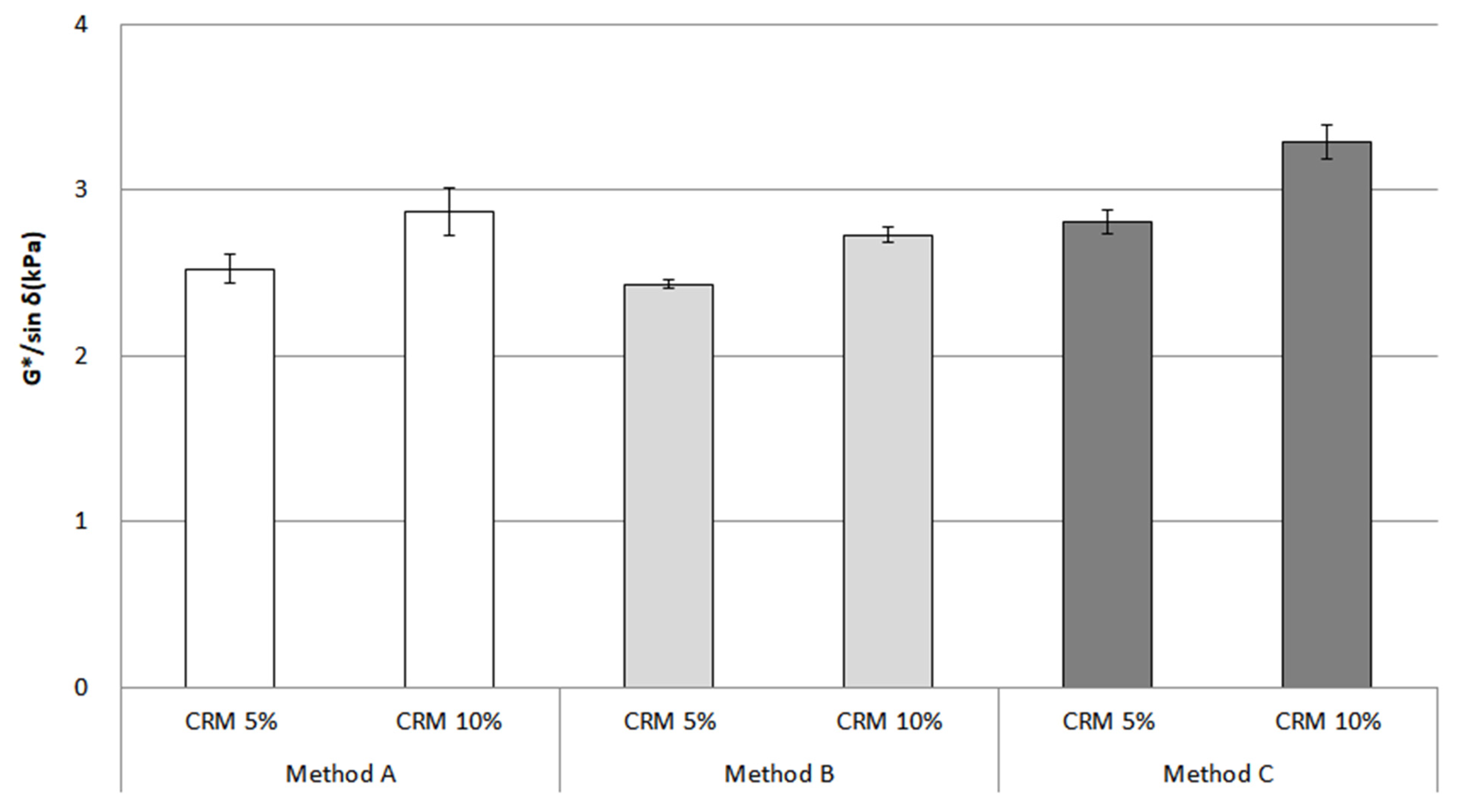
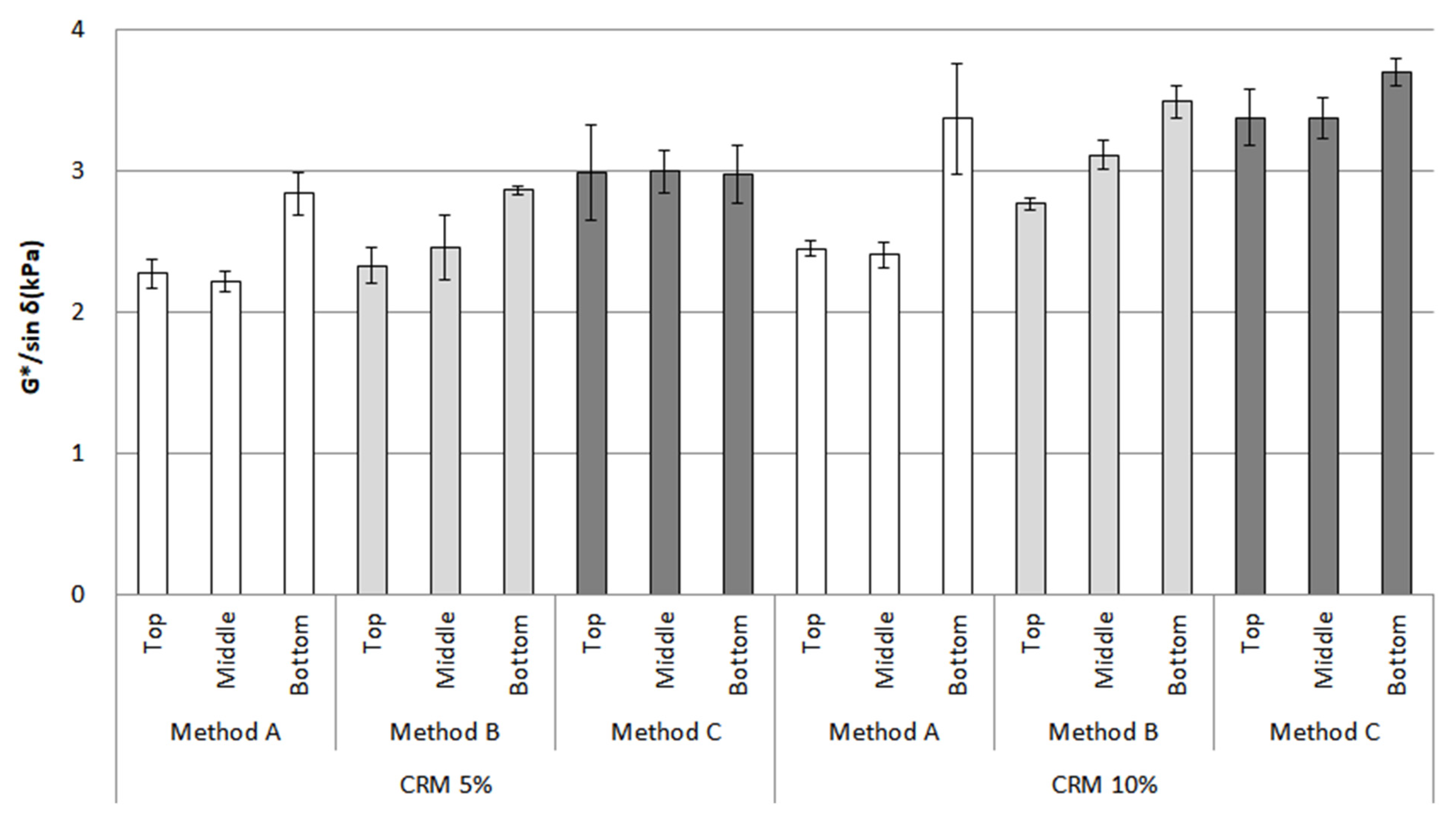
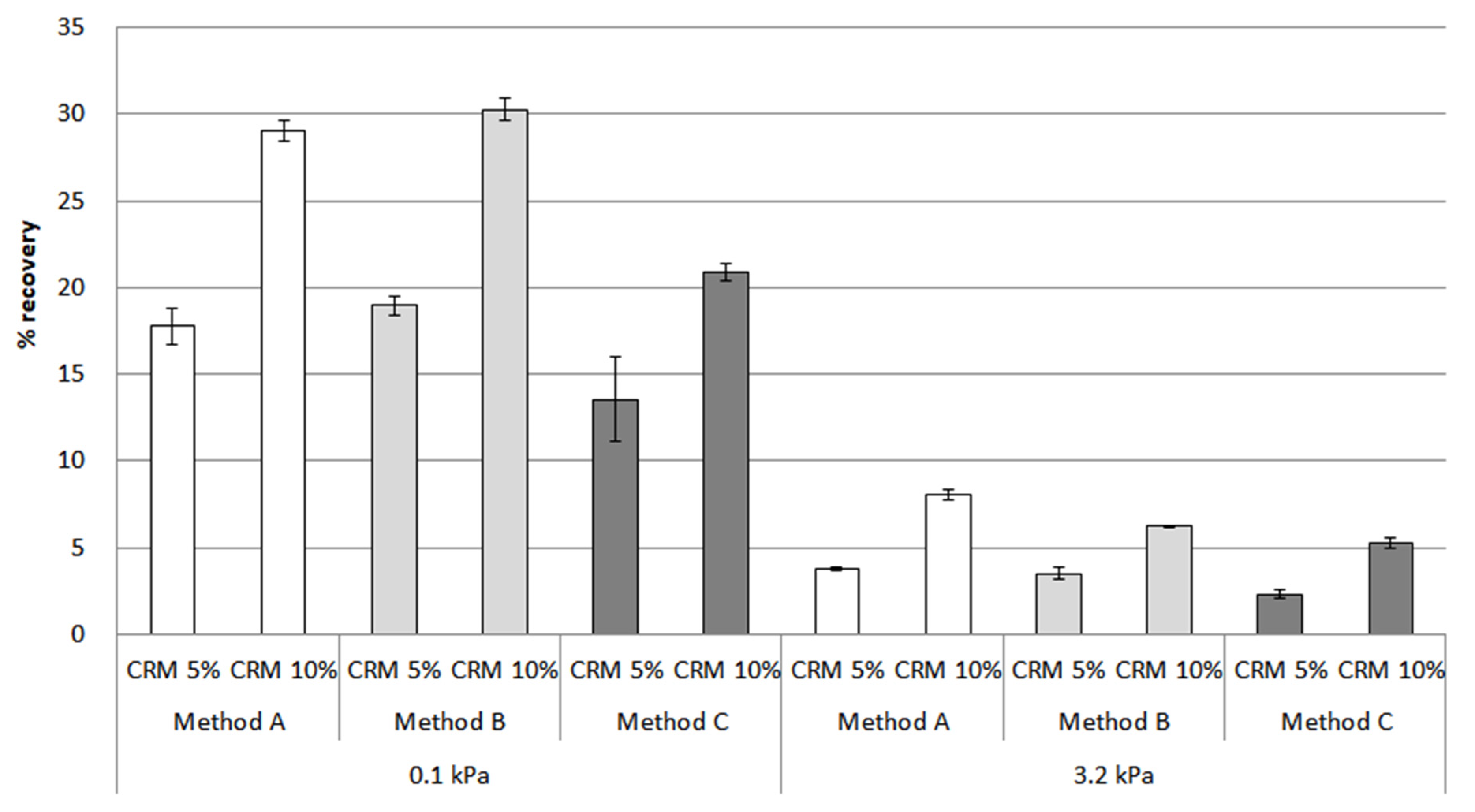
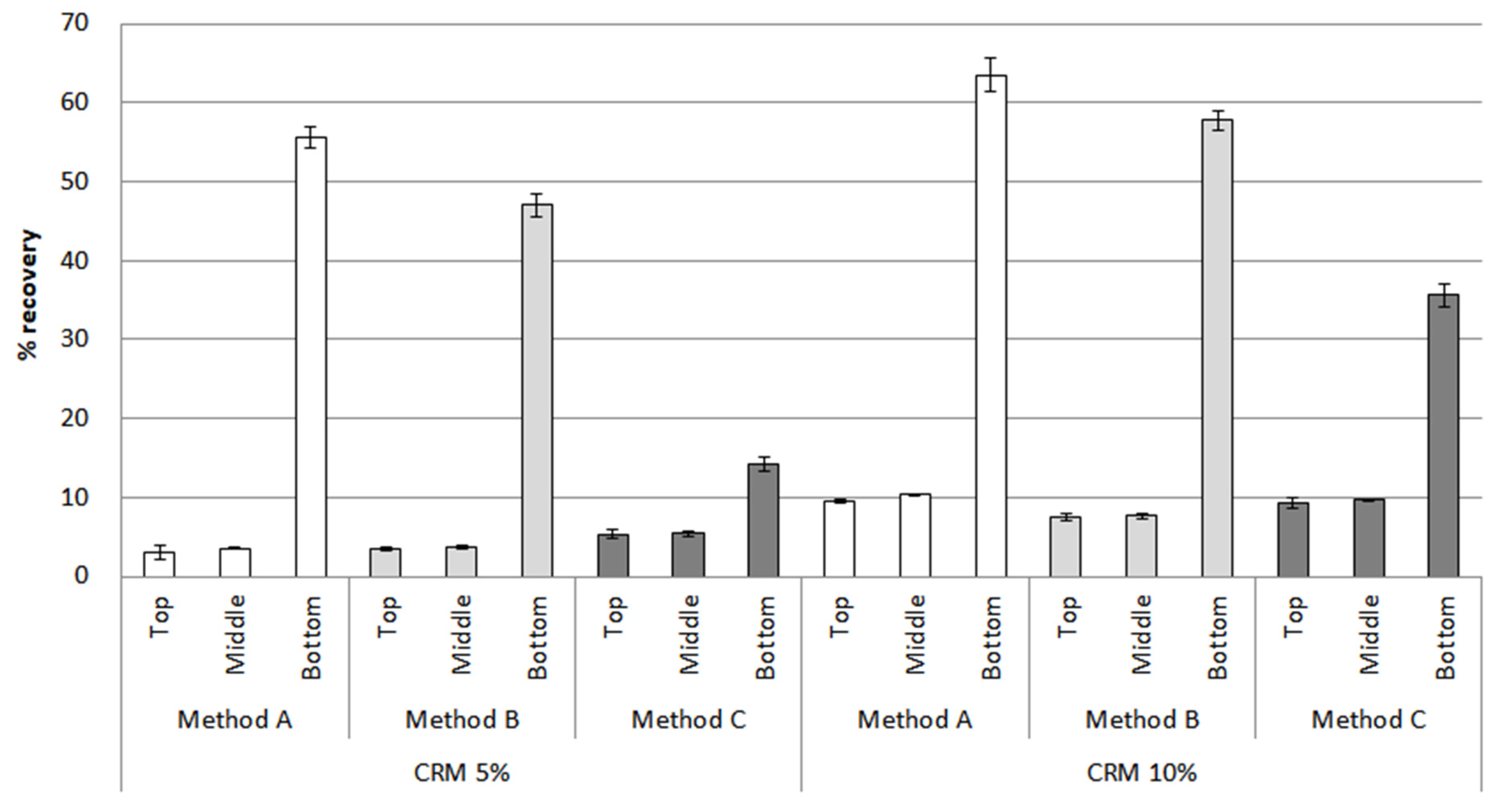
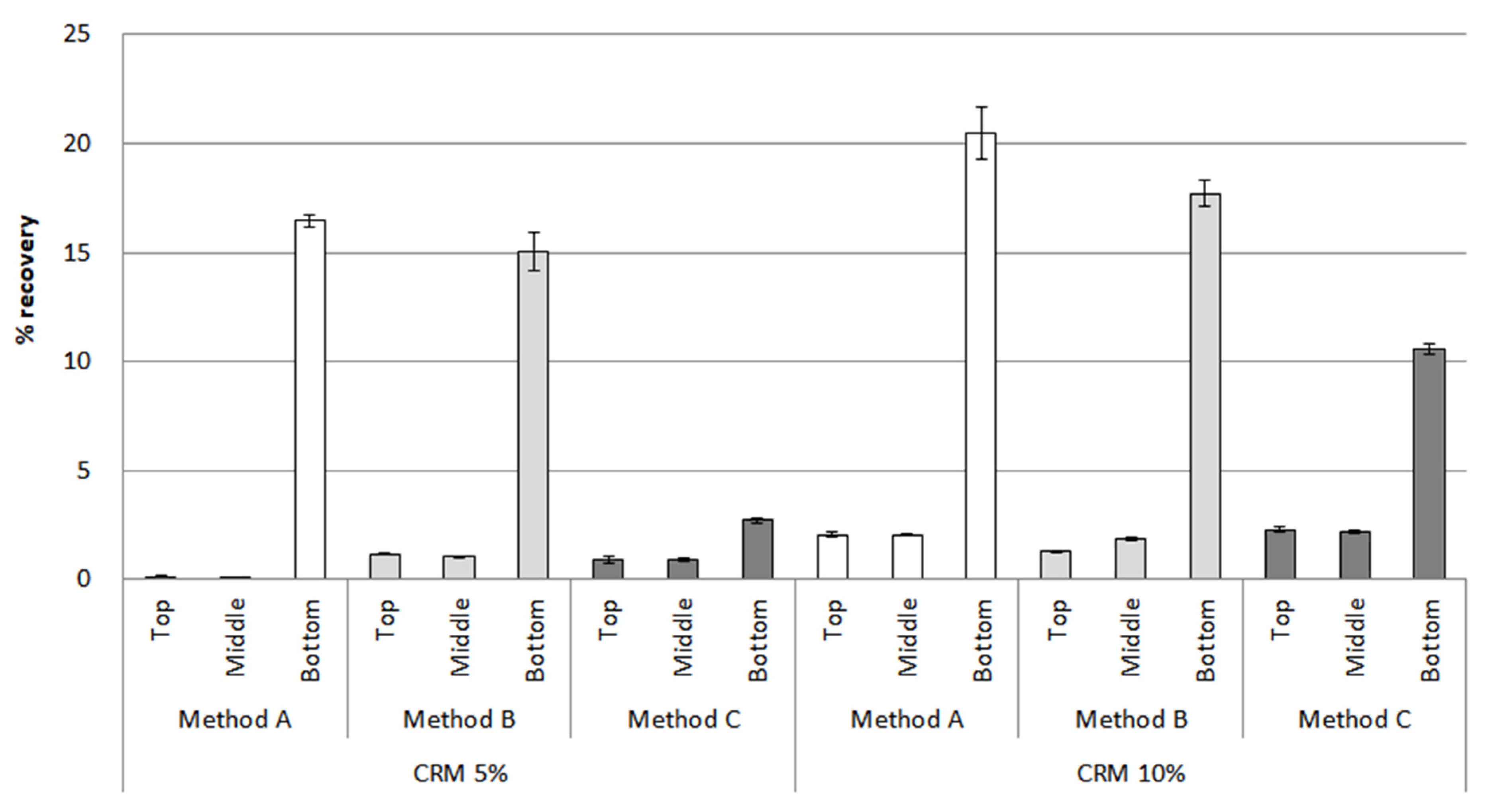


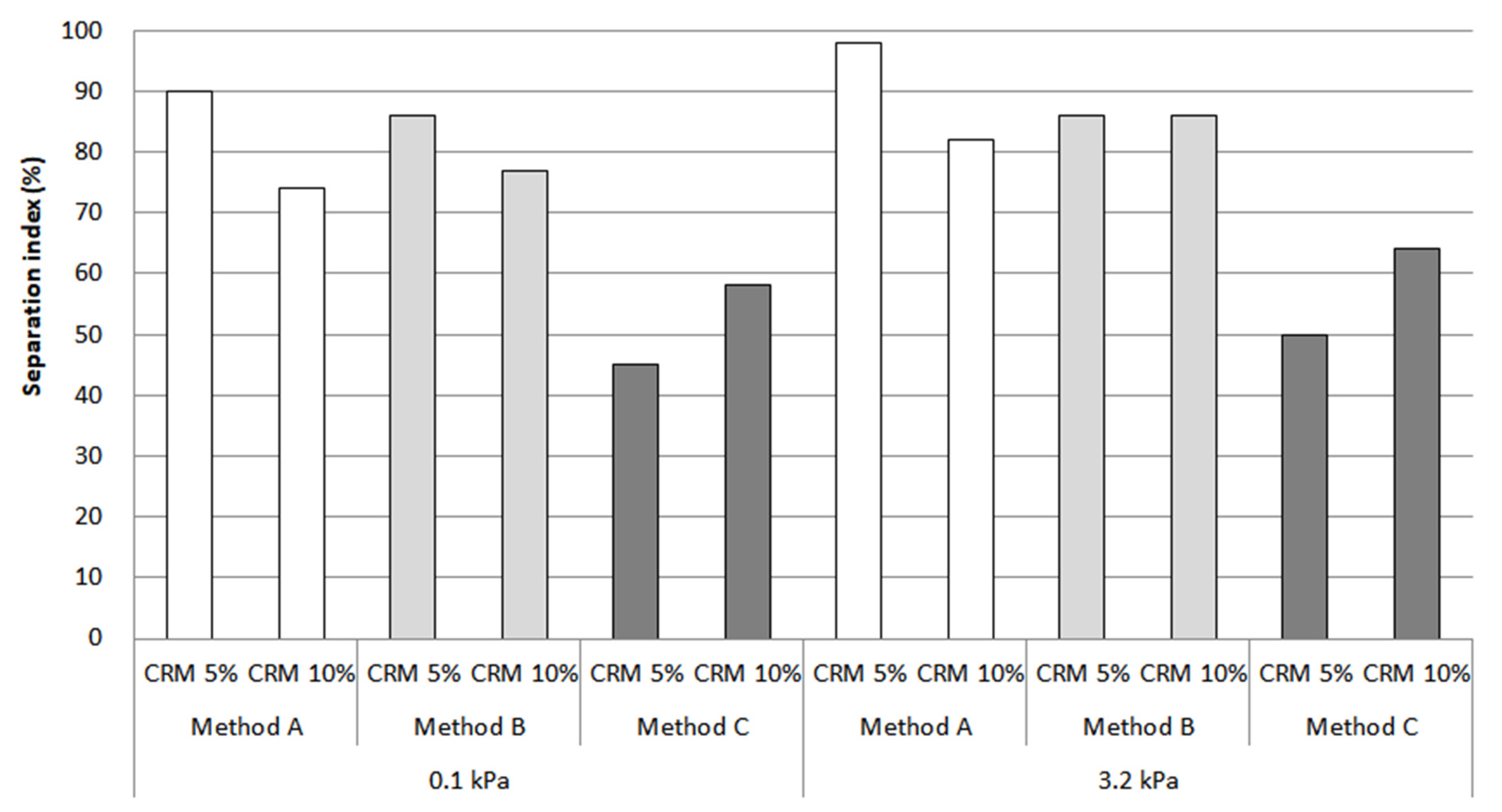
| Test Properties | Test Result | |
|---|---|---|
| Original binder | Viscosity @ 135 °C (cP) | 538 |
| G*/sin δ @ 64 °C (kPa) | 1.38 | |
| RTFO aged binder | G*/sin δ @ 64 °C (kPa) | 3.82 |
| RTFO + PAV aged binder | G*/sin δ @ 25 °C (kPa) | 4402 |
| Stiffness @ −12 °C (MPa) | 205 | |
| m-value @ −12 °C | 0.323 |
| Sieve Number (μm) | % Cumulative Passed |
|---|---|
| 30 (600) | 100 |
| 50 (300) | 57.7 |
| 100 (150) | 14.2 |
| 200 (75) | 0.0 |
| 135 °C | ||||||||||||||||||||
|---|---|---|---|---|---|---|---|---|---|---|---|---|---|---|---|---|---|---|---|---|
| CRM 5% | CRM 10% | |||||||||||||||||||
| Method A | Method B | Method C | Method A | Method B | Method C | |||||||||||||||
| O | T | B | O | T | B | O | T | B | O | T | B | O | T | B | O | T | B | |||
| CRM 5% | Method A | O | - | N | S | N | N | S | N | N | N | N | N | S | N | N | S | N | N | S |
| T | - | S | S | N | S | N | N | S | N | N | S | S | N | S | N | N | S | |||
| B | - | S | S | S | S | S | S | S | S | S | S | S | S | S | S | S | ||||
| Method B | O | - | S | S | N | N | N | N | N | S | N | N | S | N | N | S | ||||
| T | - | S | N | N | S | N | N | S | S | N | S | N | N | S | ||||||
| B | - | S | S | S | S | S | S | S | S | S | S | S | S | |||||||
| Method C | O | - | N | N | N | N | S | S | N | S | N | N | S | |||||||
| T | - | N | N | N | S | S | N | S | N | N | S | |||||||||
| B | - | N | N | S | N | N | S | N | N | S | ||||||||||
| CRM 10% | Method A | O | - | N | S | N | N | S | N | N | S | |||||||||
| T | - | S | S | N | S | N | N | S | ||||||||||||
| B | - | S | S | S | S | S | S | |||||||||||||
| Method B | O | - | S | S | N | N | S | |||||||||||||
| T | - | S | N | N | S | |||||||||||||||
| B | - | S | S | S | ||||||||||||||||
| Method C | O | - | N | S | ||||||||||||||||
| T | - | S | ||||||||||||||||||
| B | - | |||||||||||||||||||
| 180 °C | ||||||||||||||||||||
| CRM 5% | Method A | O | - | S | S | S | N | S | N | S | S | S | S | S | S | N | S | S | S | S |
| T | - | S | S | S | S | S | S | S | S | S | S | S | S | S | S | S | S | |||
| B | - | S | S | S | S | S | S | S | S | S | S | S | N | S | S | S | ||||
| Method B | O | - | S | S | N | N | S | N | N | S | S | N | S | N | N | S | ||||
| T | - | S | N | S | S | S | N | S | S | N | S | N | S | S | ||||||
| B | - | S | S | S | S | S | S | S | S | S | S | S | S | |||||||
| Method C | O | - | N | S | N | N | S | S | N | S | N | N | S | |||||||
| T | - | S | N | N | S | S | N | S | N | N | S | |||||||||
| B | - | S | S | S | S | S | S | S | S | S | ||||||||||
| CRM 10% | Method A | O | - | N | S | S | N | S | N | N | S | |||||||||
| T | - | S | S | N | S | N | N | S | ||||||||||||
| B | - | S | S | S | S | S | S | |||||||||||||
| Method B | O | - | S | S | S | S | S | |||||||||||||
| T | - | S | N | N | S | |||||||||||||||
| B | - | S | S | S | ||||||||||||||||
| Method C | O | - | N | S | ||||||||||||||||
| T | - | S | ||||||||||||||||||
| B | - | |||||||||||||||||||
| G*/sin δ | ||||||||||||||||||||
|---|---|---|---|---|---|---|---|---|---|---|---|---|---|---|---|---|---|---|---|---|
| CRM 5% | CRM 10% | |||||||||||||||||||
| Method A | Method B | Method C | Method A | Method B | Method C | |||||||||||||||
| O | T | B | O | T | B | O | T | B | O | T | B | O | T | B | O | T | B | |||
| CRM 5% | Method A | O | - | N | S | N | N | S | S | S | S | S | N | S | N | N | S | S | S | S |
| T | - | S | N | N | S | S | S | S | S | N | S | S | S | S | S | S | S | |||
| B | - | S | S | N | N | N | N | N | S | S | N | N | S | S | S | S | ||||
| Method B | O | - | N | S | S | S | S | S | N | S | S | S | S | S | S | S | ||||
| T | - | S | S | S | S | S | N | S | S | S | S | S | S | S | ||||||
| B | - | N | N | N | N | S | S | N | N | S | S | S | S | |||||||
| Method C | O | - | N | N | N | S | S | N | N | S | S | S | S | |||||||
| T | - | N | N | S | S | N | N | S | S | S | S | |||||||||
| B | - | N | S | S | N | N | S | S | S | S | ||||||||||
| CRM 10% | Method A | O | - | S | S | N | N | S | S | S | S | |||||||||
| T | - | S | S | S | S | S | S | S | ||||||||||||
| B | - | S | S | N | N | N | S | |||||||||||||
| Method B | O | - | N | S | S | S | S | |||||||||||||
| T | - | S | S | S | S | |||||||||||||||
| B | - | N | N | N | ||||||||||||||||
| Method C | O | - | N | S | ||||||||||||||||
| T | - | S | ||||||||||||||||||
| B | - | |||||||||||||||||||
| 0.1 kPa | ||||||||||||||||||||
|---|---|---|---|---|---|---|---|---|---|---|---|---|---|---|---|---|---|---|---|---|
| CRM 5% | CRM 10% | |||||||||||||||||||
| Method A | Method B | Method C | Method A | Method B | Method C | |||||||||||||||
| O | T | B | O | T | B | O | T | B | O | T | B | O | T | B | O | T | B | |||
| CRM 5% | Method A | O | - | S | S | N | S | S | S | S | S | S | S | S | S | S | S | S | S | S |
| T | - | S | S | N | S | S | S | S | S | S | S | S | S | S | S | S | S | |||
| B | - | S | S | S | S | S | S | S | S | S | S | S | S | S | S | S | ||||
| Method B | O | - | S | S | S | S | S | S | S | S | S | S | S | S | S | S | ||||
| T | - | S | S | S | S | S | S | S | S | S | S | S | S | S | ||||||
| B | - | S | S | S | S | S | S | S | S | S | S | S | S | |||||||
| Method C | O | - | S | N | S | S | S | S | S | S | S | S | S | |||||||
| T | - | S | S | S | S | S | S | S | S | S | S | |||||||||
| B | - | S | S | S | S | S | S | S | S | S | ||||||||||
| CRM 10% | Method A | O | - | S | S | N | S | S | S | S | S | |||||||||
| T | - | S | S | S | S | S | S | S | ||||||||||||
| B | - | S | S | S | S | S | S | |||||||||||||
| Method B | O | - | S | S | S | S | S | |||||||||||||
| T | - | S | S | S | S | |||||||||||||||
| B | - | S | S | S | ||||||||||||||||
| Method C | O | - | S | S | ||||||||||||||||
| T | - | S | ||||||||||||||||||
| B | - | |||||||||||||||||||
| 3.2 kPa | ||||||||||||||||||||
| CRM 5% | Method A | O | - | S | S | N | S | S | S | S | S | S | S | S | S | S | S | S | S | S |
| T | - | S | S | S | S | S | S | S | S | S | S | S | S | S | S | S | S | |||
| B | - | S | S | S | S | S | S | S | S | S | S | S | S | S | S | S | ||||
| Method B | O | - | S | S | S | S | S | S | S | S | S | S | S | S | S | S | ||||
| T | - | S | S | N | S | S | S | S | S | N | S | S | S | S | ||||||
| B | - | S | S | S | S | S | S | S | S | S | S | S | S | |||||||
| Method C | O | - | S | N | S | N | S | S | S | S | S | N | S | |||||||
| T | - | S | S | S | S | S | N | S | S | S | S | |||||||||
| B | - | S | N | S | S | S | S | S | S | N | ||||||||||
| CRM 10% | Method A | O | - | S | S | S | S | S | S | S | S | |||||||||
| T | - | S | S | S | S | S | N | S | ||||||||||||
| B | - | S | S | S | S | S | S | |||||||||||||
| Method B | O | - | S | S | S | S | S | |||||||||||||
| T | - | S | S | S | S | |||||||||||||||
| B | - | S | S | S | ||||||||||||||||
| Method C | O | - | S | S | ||||||||||||||||
| T | - | S | ||||||||||||||||||
| B | - | |||||||||||||||||||
Disclaimer/Publisher’s Note: The statements, opinions and data contained in all publications are solely those of the individual author(s) and contributor(s) and not of MDPI and/or the editor(s). MDPI and/or the editor(s) disclaim responsibility for any injury to people or property resulting from any ideas, methods, instructions or products referred to in the content. |
© 2023 by the authors. Licensee MDPI, Basel, Switzerland. This article is an open access article distributed under the terms and conditions of the Creative Commons Attribution (CC BY) license (https://creativecommons.org/licenses/by/4.0/).
Share and Cite
Yun, J.; Vigneswaran, S.; Lee, M.-S.; Choi, P.; Lee, S.-J. Effect of Blending and Curing Conditions on the Storage Stability of Rubberized Asphalt Binders. Materials 2023, 16, 978. https://doi.org/10.3390/ma16030978
Yun J, Vigneswaran S, Lee M-S, Choi P, Lee S-J. Effect of Blending and Curing Conditions on the Storage Stability of Rubberized Asphalt Binders. Materials. 2023; 16(3):978. https://doi.org/10.3390/ma16030978
Chicago/Turabian StyleYun, Jihyeon, Shyaamkrishnan Vigneswaran, Moon-Sup Lee, Pangil Choi, and Soon-Jae Lee. 2023. "Effect of Blending and Curing Conditions on the Storage Stability of Rubberized Asphalt Binders" Materials 16, no. 3: 978. https://doi.org/10.3390/ma16030978
APA StyleYun, J., Vigneswaran, S., Lee, M.-S., Choi, P., & Lee, S.-J. (2023). Effect of Blending and Curing Conditions on the Storage Stability of Rubberized Asphalt Binders. Materials, 16(3), 978. https://doi.org/10.3390/ma16030978






